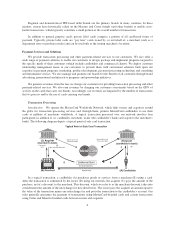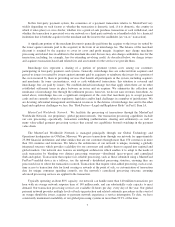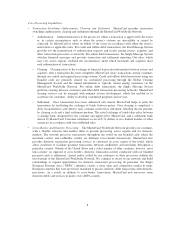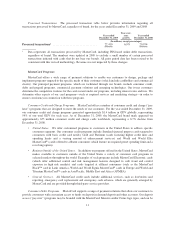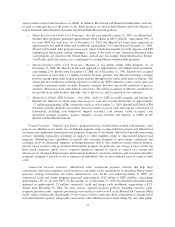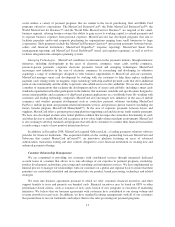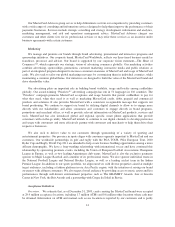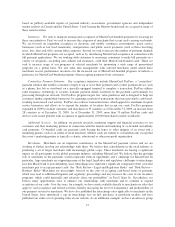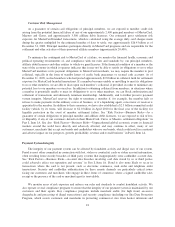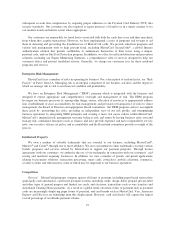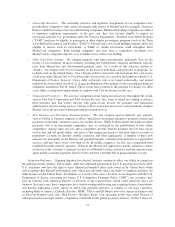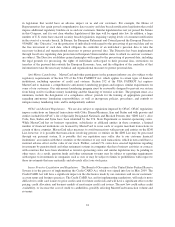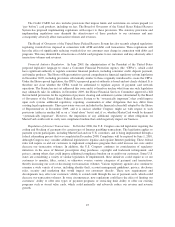MasterCard 2009 Annual Report Download - page 26
Download and view the complete annual report
Please find page 26 of the 2009 MasterCard annual report below. You can navigate through the pages in the report by either clicking on the pages listed below, or by using the keyword search tool below to find specific information within the annual report.which brings together merchants, acquirers, issuers and processors twice a year to examine payments innovation
at the point of interaction, and to seek to enhance the experience for merchants and consumers at the point of sale
or in an online shopping environment for a retail sales transaction. We also continue to develop our acquirer and
merchant sales teams around the world. Moreover, we have recently introduced a suite of information products,
data analytics and marketing services which can help merchants understand specific activity in their industry,
evaluate their sales performance against competitors and focus direct marketing efforts to target desirable
prospects and hard to reach segments.
MasterCard Revenue Sources
MasterCard processes transactions denominated in more than 150 currencies through our global system,
providing cardholders with the ability to utilize, and merchants to accept, MasterCard cards across multiple
country borders. For example, we may process a transaction in a merchant’s local currency; however the charge
for the transaction would appear on the cardholder’s statement in the cardholder’s home currency. We process
most of the cross-border transactions using MasterCard, Maestro and Cirrus-branded cards and process the
majority of MasterCard-branded domestic transactions in the United States, United Kingdom, Canada, Brazil and
Australia.
MasterCard generates revenues by charging fees to our customers for providing transaction processing and
other payment-related services and assessing our customers based on the dollar volume of activity on the cards
that carry our brands. Our net revenues are classified into the following five categories:
•Domestic assessments: Domestic assessments are fees charged to issuers and acquirers based
primarily on the volume of activity on MasterCard and Maestro-branded cards where the merchant
country and the cardholder country are the same. A portion of these assessments is estimated based on
aggregate transaction information collected from our systems and projected customer performance and
are calculated by converting the aggregate volume of usage (purchases, cash disbursements, balance
transfers and convenience checks) from local currency to the billing currency and then multiplying by
the specific price. In addition, domestic assessments include items such as card assessments, which are
fees charged on the number of cards issued or assessments for specific purposes, such as acceptance
development or market development programs. Acceptance development fees are charged primarily to
U.S. issuers based on components of volume, and support our focus on developing merchant
relationships and promoting acceptance at the point of sale.
•Cross-border volume fees: Cross-border volume fees are charged to issuers and acquirers based on the
volume of activity on MasterCard and Maestro-branded cards where the merchant country and
cardholder country are different. Cross-border volume fees are calculated by converting the aggregate
volume of usage (purchases and cash disbursements) from local currency to the billing currency and
then multiplying by the specific price. Cross-border volume fees also include fees, charged to issuers,
for performing currency conversion services.
•Transaction processing fees: Transaction processing fees are charged for both domestic and cross-
border transactions and are primarily based on the number of transactions. These fees are calculated by
multiplying the number and type of transactions by the specific price for each service. Transaction
processing fees include charges for transaction switching (authorization, clearing and settlement) and
connectivity.
•Other revenues: Other revenues for other payment-related services are primarily dependent on the
nature of the products or services provided to our customers but are also impacted by other factors, such
as contractual agreements. Examples of other revenues are fees associated with fraud products and
services, cardholder service fees, consulting and research fees, compliance and penalty fees, account and
transaction enhancement services, holograms and publications.
16


